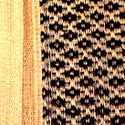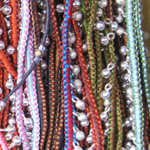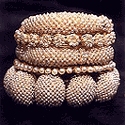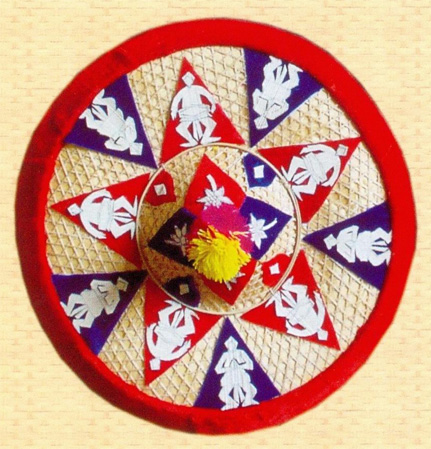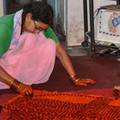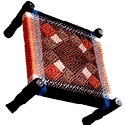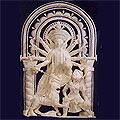Extremely delicate, the mats made with kora / sedge grass are highly prized and valued; Kora grass grows abundantly along the banks of the rivers and in marshy areas.The process of creating the mat is complex and painstaking. In its original form the grass is green in colour and normally grows to a height of 3-4 feet. The grass for the mats is cut very finely while it is still green. The grass is collected in the months of September/ October and February/March. The inside white pith (choi) of the stem is removed with a sharp-edged knife while the outer part of the stem is used for weaving. The counts of the mat depend on how many strips the grass is cut into; the greater the number of strips from each stem the higher the count. The strips of grass are then dried in the hot sun. They are, however, never exposed to humidity, as they tend to turn black with the exposure. When the dried grass strips turn a yellowish greenish colour they are boiled in a pot of water and then dried again. The dried grass is made up into bundles and then soaked in running water. These bundles are weighed down with stones at both ends; they are then made to float in running streams of clean water. The weight of the stone is so adjusted that the grass remains just below the surface of the water. The grass is normally kept under water for three days, but sometimes it is kept under water for up to seven days, ensuring a very fine count. This wetting causes the grass to swell up to three times its original size. It is then dried again in the sun. The weaving is done on a floor loom. The process is slow and follows a basket weave pattern. The weft (or the grass) covers the warp entirely and the pattern formed has an interesting striped effect of its own. Once the weavings is complete, the mat is dried in the sun for a short while. It is then finished with a polishing stone. Traditionally only two colours --- red and black --- were used on the mats. For dyeing the grass both natural and chemical dyes are used. The natural dye is taken from sappon or Brazil wood and is fixed with an alum mordant. With the introduction of chemical dyes a wide range of colours have been introduced into the mats. The warp on which the grass mats are woven was traditionally made of elephant aloe fibre. However, the weavers have now started using cotton or silk yarn as a substitute in the warp while weaving. The warp is made by the men while the weaving is done by the women. The mats produced include the 5 feet x 3 feet sleeping mat, prayer mats, table mats, and panthi mats which are used to sit on while eating. The designs on the mats are constantly evolving, changing from simple stripes to reproductions of monuments, animals, plants, and trees. The mats woven in Pattamadai are very fine with counts ranging from 100 to 140. Kora mats are extremely reliable and can be easily folded.
Extremely delicate, the mats made with kora / sedge grass are highly prized and valued; Kora grass grows abundantly along the banks of the rivers and in marshy areas and the mats are woven both in Tamil Nadu and Kerala. The process of creating the mat is complex and painstaking. In its original form the grass is green in colour and normally grows to a height of 3-4 feet. The grass for the mats is cut very finely while it is still green. The grass is collected in the months of September/ October and February/March. The inside white pith (choi) of the stem is removed with a sharp-edged knife while the outer part of the stem is used for weaving. The counts of the mat depend on how many strips the grass is cut into; the greater the number of strips from each stem the higher the count. The strips of grass are then dried in the hot sun. They are, however, never exposed to humidity, as they tend to turn black with the exposure. When the dried grass strips turn a yellowish greenish colour they are boiled in a pot of water and then dried again. The dried grass is made up into bundles and then soaked in running water. These bundles are weighed down with stones at both ends; they are then made to float in running streams of clean water. The weight of the stone is so adjusted that the grass remains just below the surface of the water. The grass is normally kept under water for three days, but sometimes it is kept under water for up to seven days, ensuring a very fine count. This wetting causes the grass to swell up to three times its original size. It is then dried again in the sun. The weaving is done on a floor loom. The process is slow and follows a basket weave pattern. The weft (or the grass) covers the warp entirely and the pattern formed has an interesting striped effect of its own. Once the weavings is complete, the mat is dried in the sun for a short while. It is then finished with a polishing stone. Traditionally only two colours --- red and black --- were used on the mats. For dyeing the grass both natural and chemical dyes are used. The natural dye is taken from sappon or Brazil wood and is fixed with an alum mordant. With the introduction of chemical dyes a wide range of colours have been introduced into the mats. The warp on which the grass mats are woven was traditionally made of elephant aloe fibre. However, the weavers have now started using cotton or silk yarn as a substitute in the warp while weaving. The warp is made by the men while the weaving is done by the women. The mats produced include the 5 feet x 3 feet sleeping mat, prayer mats, table mats, and panthi mats which are used to sit on while eating. The designs on the mats are constantly evolving, changing from simple stripes to reproductions of monuments, animals, plants, and trees. The mats woven in Pattamadai are very fine with counts ranging from 100 to 140. Kora mats are extremely reliable and can be easily folded.
The famous Patteda Anchu sarees belong to North Karanataka. These traditional sarees formed part of the wedding trousseau of a bride, especially gifted to her by the father as blessing. It would first be presented to the Yellama goddess, and then given to the daughter. According to passed on stories, these sarees were also given to the devadasis as a traditional offering.
Gudara means tent and the patti gudara of Karnataka is woven with a cotton yarn of a narrow width on a pit-loom. The woven cloth pieces are then joined together in an artistic manner with a line design of zig-zag stitches using coloured yarn.
This is mainly practised by the Patwa tribe. The materials used for this craft are glass beads and coloured thread. Glass-beads are made into chains, hair grips, necklaces and chains by stringing on thread or twine with many variation of colours and designs patterns. Coloured threads are twisted and manipulated to form various ornaments hair decorations, neck pieces and bracelets.
Pawndum is an essential traditional cloth of the Mizo community. It is a rectangular piece of fabric used as a body wrap by both men and women. The cloth has a black background with red and grey stripes covering it. Like most traditional Mizo textiles, it is made of two-loom widths. While the base weft is always made of black yarn, the bold warp stripes use dyed cotton. The dyeing techniques used are a combination of traditional natural dyes as well as chemical dyes. Today, soap dyes are much in demand as they allow the artists to express their imagination through a wide spectrum of colours. The Pawndum is wrapped around the waist such that it covers the lower part of the body till the feet. This beautifully contrasting cloth is worn both as a casual garment and also on special occasions. Earlier,it was customary to wear the Pawndum for certain Mizo dances and marriages, but today it is mostly worn on days of mourning and death.
Payyannur Pavithra Mothiram is a kind of gold ring Indians wear for its ritualistic value. This holy ring is worn during the rituals of “pithru bali”, or the prayers for a person’s dead ancestors. This ring was traditionally made of “dharba” grass, however the modern one is made of gold. The shape of the ring is unique as it looks like a knot. Silver is also used for making the ring. It is worn on the right ring finger while performing pujas for dead ancestors. The origin of the holy ring is associated with the history of the Payyannur Subramanya temple. The temple used to insist on the wearing of grass rings while performing holy rites. Later, the priests switched to gold rings for the purpose of durability. A traditional craftsman take a whole day to make one ring. The eating of meat and drinking of alcohol is prohibited for those who want to become holy artisans. The word “pavithram” means purity while “mothiram” means ring. Both these are Malayalam words which is the local language of Kerala.
Pearl jewellery in Andhra Pradesh is found chiefly in the Masulipatnam region and, to a lesser extent, in the old city of Hyderabad. A variety of products, like bangles, necklaces, rings, lockets, anklets, key chains, ear studs, and figures of deities, are crafted.
India has a rich culture of producing fragrances and aromatics using materials obtained from nature. Aromatic flowers such as rose, jasmine, marigold and henna are known for their 'sugandh' and are most commonly translated into scented candles, colognes, perfumes and agarbattis. Barks of certain plants are also utilised to extract scented liquids like oud, herbs and spices. In Gujarat, sandalwood is a common fragrance that gets translated to many such products.
These cloth scroll-paintings in folk styles are known as phads and they depict the lives of local heroes. They tell the story of Pabuji Ramdevji and Dev Narainji whose exploits are sung by minstrels or bhopas in the villages. Vegetable colours are used on cloth and paper and historical themes are depicted. Vibrant colours and bold lines, along with a two-dimensional treatment of figures, and the entire composition arranged in sections, are characteristic of these paintings. Shahpura in Bhilwara and Udaipur are the main centres.
In appliqué work, shaped pieces of clothes are cut from waste and sewn onto fine muslin. The patchwork is economical because it eliminates the need to embroider. Earlier the appliqué was used for shamianas or tents and canopies. The appliqué was made with waste cloth. Aligarh was a well known centre for producing the tents. The canopies are produced even now for religious purposes. Lately the appliqué work has been used for decorating the dress material also. In patti ka kaam , the fabric is cut into motifs and hammed to the base fabric. The stems are attached to the fabric by stem stitch. Women do the appliqué work from their home and Rampur is a big cluster where appliqué is done. The other production clusters are Aligarh and Lucknow.
The Japi, a traditional Assamese sun-shade, continues to be an extremely well-known bamboo item. It has been in use since the days of the great Chinese traveller Hiuen Tsang who came to Assam and was welcomed with a Japi.
Traditionally, the Japis were decorated with elaborate designs and ornamentation. In Nalbari and the surrounding villages, Japis are attractively decorated against a bright red background and a spiked circle is made with two bamboo splits, one inside the other interspersed with a number of motifs like the cross, a crescent moon, and a small circle with smaller circles of butterfly designs. Although there are several types of Japi called Sorudaya Japi, Bordaya Japi, Haluwa Japi, Gorokhiya Japi, Pitha Japi and Tupi Japi, Haluwa and Gorokhiya are predominantly used.
From being known as the farmers hat to being worn as headgear by the ladies of the royal families, Japi has gone through many variations as can be seen in the culture of Assam. It is displayed with pride during the Bihu festival and felicitation ceremonies.
Phulkari- literally embroidered flowers phul = flower; karai= embroidery/embroider) - is the traditional art of crafting embroidered odhnis (head-drape[s] or chaddar (wraps/shawl[s]) used by women in the Punjab. Throughout the Punjab, in the Hindu, Muslim and Sikh communities alike, women embroidered the odhni or chaddar ornamented with phulkari and bagh, garden, a variation where the embroidery completely covers the base material. Using a basic darn stitch used to embroider from the reverse side of the fabric, with the longer float on the face, thus allowing large surfaces to be densely embroidered, the women of the Punjab lovingly and painstakingly embroidered (and continue to embroider) phulkaris- drapes that were and are not only beautiful and colourful but also linked integrally with events considered to be milestones in a woman's life. The phulkari was and is thus more that just an item of clothing; it is part of an ethos steeped in social and ritualistic traditions. In this respect, it is critical to note at the outset that every embroidered head-cloth or drape is not a phulkari; only those in which the embroidery is done using the darn stitch is known as a phulkari. It is difficult to date the beginning of the folk art of creating phulkaris. However there is the presence of references to embroidery work in the Punjab as far back as 2,000 years ago: in the Rig Veda, a critical text in the corpus of Vedic literature, as well as in other ancient scriptures where it was termed kashidakariThe term phulkari' can also be traced to the well-known folk tale of Heer-Ranjha. This tale is ascribed to the poet Waris Shah, whose ancestors had migrated to India form Iran. (In Iran, the word was gulkari- bothgul' and phul' mean flower, but Waris Shah used the term only with reference to embroidery). It seems that the craft recognisable as contemporaryphulkari work became visible during the reign of Maharaja Ranjit Singh, a time of peace and prosperity for the people of the Punjab. A settled life, allowing for leisure time was critical to the embroidering of phulkarisas the embroidering could be done only after the women had completed household chores. The women gathered during their leisure hours, usually in the afternoons, to socialise with each other: chatter, news, banter and laughter flowed while deft fingers embroidered motifs and patterns in darn stitches with pat (silk) threads - the phulkari in the making. It is thus that little girls learnt from their mothers and grandmothers, and thus that the craft tradition continued, remaining for a long time, an extremely personal and feminine folk art. The entire craft of phulkari embroidery and the embroidered drapes known as phulkaris are linked intimately with the rituals and events in a woman's life in the Punjab. By the first quarter of the nineteenth century the phulkaridrape began to be made and used by the women in the Punjab as a clothing of adornment: not merely for regular wear, but specifically for ceremonial occasions. Mothers and grandmothers embroidered phulkaris for the trousseau(s) of their daughter(s) and grand-daughter(s). Every girl's dowry included phulkaris; the draping of specially embroidered phulkaris was an integral part of marriage rituals; phulkaris were used by women to mark and celebrate childbirth; and a woman who died as a suhagan- a married woman with her husband still alive, a much-coveted situation - was draped on her funeral pyre in a phulkari. The phulkari was thus a splendid if silent witness to every event considered to be celebratory in a woman's life: it is no wonder that its making blended love and laughter with detail with dexterity, and that flowers, color and joy were woven in with innovation, art and beauty. The fabric used us usually khaddar, a heavy cotton that is locally woven in narrow widths of 45 to 60 cm joined either before or after the embroidery to form the desired size. The base fabric is most often an auspicious dark brick red, or more rarely, an indigo blue, on which the embroidery is executed in untwisted floss silk called pat, sourced from Kashmir, Afghanistan and Bengal and dyed yellow, orange, burgundy, bright pink, purple, blue and green in Amritsar and Jammu. Now embroidered across the districts of Punjab from Amritsar district to Jalandhar district, Ferozepur to, Bhathinda Moga, and to Patiala town and Tipari village . The product range has expanded to include Garments and home furnishings.
Every woman in the family-from the bride to the great grandmother-wears a ceremonial garment called Pichhaura on auspicious occasions, be it namkarana (naming ceremony), marriage, or upanayan (a ritual done during the wedding). It has a special meaning and is mandatory to be worn by all married women in the family for special occasions as well as during the preparations for making the Aipan folk paintig. Conventionally the pichhaura has traditional motifs hand printed with red colour over a yellow background. This can most notably be found in Almora, a district in the Kumaon region of Uttarakhand. Traditionally only a ceremonial shawl is made by women artisans on chikan karahi cloth at home. However with the changing trends one may now find men also making the shawls and other items for the purpose of selling them in shops. Two fifty meters long white fabric with chikan karahi is purchased from Delhi for making the shawls. Earlier the dye too was purchased from Delhi however now it is available in local markets. The shawl is characterized by the use of the red and yellow colours as they together symbolize long marital life, health and prosperity. The cloth is dipped in a solution of water, yellow colour dye and any locally available adhesive. It is then soaked in the solution for five minutes. Using a red colour solution designs are made while the cloth is still wet. These designs are made with the help of a 50 paisa coin or a gram seed tied in a piece of cloth, which is dipped in the red colour solution. Line patterns are made using 50 paisa coins while the dot patterns are made using gram seeds. The design made in the middle of the cloth is referred to as 'Surya Chandra Codi'. The design consists of Surya (Sun God), Chandra (Moon), Ghanti (bell), and shankh (shell) which is considered auspicious. The remaining area of the cloth is covered with a dotted design. After the design is made, the cloth is dried in the sun. Once it has dried, golden or silver colour lace locally known as 'kiran' is stitched on the edges.
Pichhwais are created for the shrine of Shri Bathji at nathdwara and other temples of the Pushti Marga. Objects such as painted wall hangings and paintings on cloth and paper are created under this craft form. Tools such as broad brushes of goat tail hair, coconut shell containers for colors, agate burnishing tool, charcoal from tamarind twigs etc. are used for the crafting process. Real gold and stone colours are used on these cloth paintings that are intended as backdrops for the statue of the temple deity. These were originally made for different seasons and festivals but were later sold to pilgrims. A thin layer of starch is applied on the cloth and the painting is done in tempera. The themes found are from the ras leela of Sri Krishna and the gopis. Srinathji or Krishna is found in all the paintings in a typical luminous blue. These paintings are also used for story-telling purposes in the villages. The main centre for these paintings is Nathdwara and the name 'Pichwai' is because these paintings are hung in the temples behind (piche) the statue of the deity. Jaipur and Udaipur are the other two centres.
The technique of combining pieces of different woods with their grains and colours are creatively utilized to achieve patterns or pictorial compositions as wall hangings, panels and display. Other wall displays include Kathakali masks, Candle stands, Key stands, Boxes etc. Production centers are in Maradu in Ernakulam district and Thalayokaparambu in Koftayam district. This craft technique involves the gluing of layers of wood together so as to create specific forms and structures. During the last decade several decorative forms of laminated constructions have been put into practice; these include the traditional blocking technique, the segmented ring method, the band saw method and the mitred laminate design. Increased ornamentation is achieved through the introduction of brass work on laminated wood. In the inlay technique, the surface of the wood is prepared and a variety of colored materials are shaped and set into precisely contoured matching cavities in order to create an illusion. The inset material could be variously colored woods, ivory that is now banned, plastic or bone , each chosen with care to enhance the illustration.
Pidi is a low stool which has its seat made with strands of thread twined to form interesting coloured patterns. The thickness of the thread varies from article to article; for instance a charpai or bed is made with a thicker twine. One of the favourite patterns is the gianichorkachatta which is a maze consisting of a secret passage made by Giani, the famous thief. Another favourite pattern is the design of a game of dice locally called pachhisi. The reverse side of the pidi always has a different design.
Pineapple is abundant in Meghalaya. Fibre from the leaves of the pineapple tree is utilised for making various types of nets. The most important centre for this craft is Tynrong. These are mainly used for carrying fish and other small articles like bags and purses.
Sholapith/ Pith/ Aeschynomene Indica/ Netti is derived from a reed which is pure white in colour and is exposed when the outer layer of the stalk is shaved. The core is light, porous, soft, and pliable and can be shaped to suit the imagination of the artisan. Dextrous hands shape this reed into many objects: scaled down models of temples, churches and mosques, carved images of Durga during puja time in Bengal, marriage headgear, flowers and garlands, toys and mobiles are all crafted from this reed.
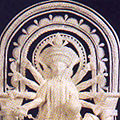



Sholapith/ Pith/ Aeschynomene Indica/ Netti is derived from a reed which is pure white in colour and is exposed when the outer layer of the stalk is shaved. The core is light, porous, soft, and pliable and can be shaped to suit the imagination of the artisan. Dextrous hands shape this reed into many objects: scaled down models of temples, churches and mosques, carved images of Durga during puja time in Bengal, marriage headgear, flowers and garlands, toys and mobiles are all crafted from this reed.




